“There are several types of welding joints in metal manufacturing, So, it can cater to the countless metal joining needs according to specific requirements and design complexity.”
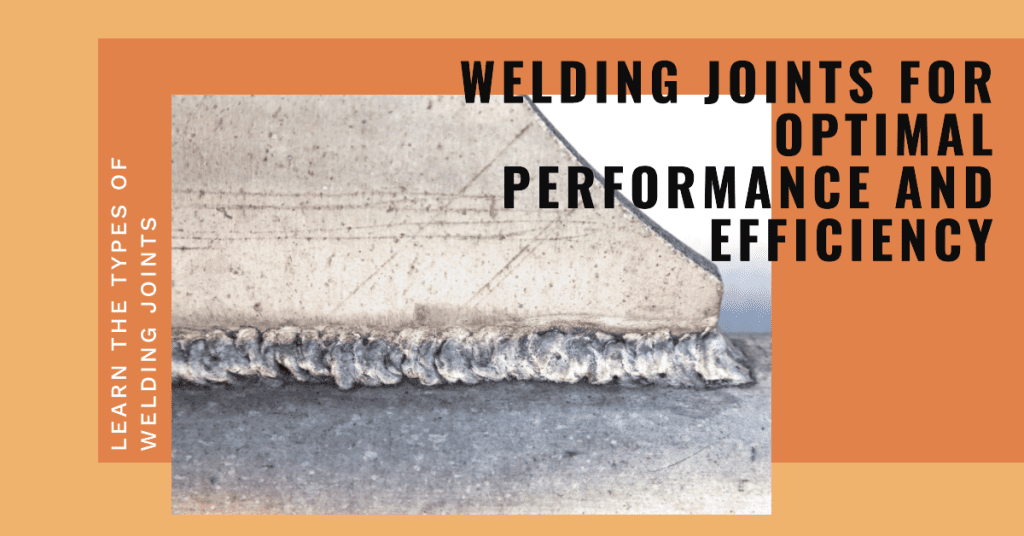
Welding is the process of joining two or more pieces of metal together by melting the materials at their point of contact and adding a filler material to form a strong bond. It is known for creating robust and durable joints. However, which welding methods to choose depends on the types of welding joints you need. Furthermore, this article will explore the various types of welding joints and their applications with tips for achieving quality welds.
Types of Welding Joints: Why They Matter
The effectiveness and strength of a welded connection depend on several factors, including the materials used, the welding process employed, and the type of weld joint created. Subsequently, welding joints are the specific configurations in which the pieces of metal are welded together.
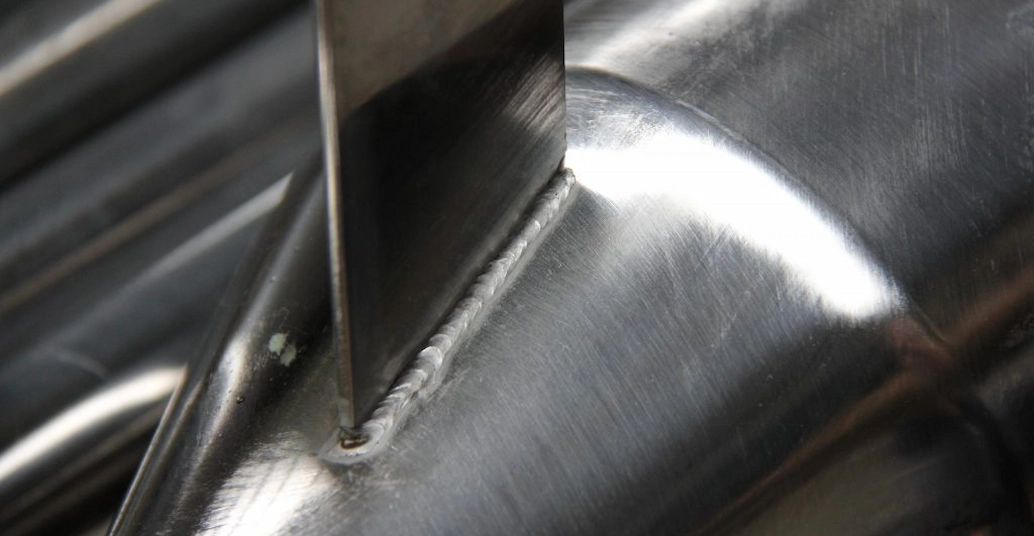
Metal welding joint
Moreover, the appropriate weld joint type selection is crucial, as it can significantly affect the quality and performance of the finished product. Weld joints not only influence the strength and durability of a connection but also impact the overall efficiency of the welding process.
Certain joint types may require more time or resources to complete, while others may introduce additional challenges in terms of positioning or accessibility. As such, understanding the various sheet metal welding joint types and their applications is vital for both novice and experienced welders alike.
Related: Welding vs Other Metal Joining Techniques: A Comprehensive Comparison
Five Types of Welding Joints: An Overview
There are five primary types of welding joints: butt, corner, lap, edge, and T-joint. Each of these joints has its own unique characteristics, strengths, and weaknesses, making them suited to different applications and scenarios. This section will provide a brief overview of each type, with more in-depth discussions to follow in the subsequent sections.

Different types of weld-joints
| Weld Joint Type | Description | Common Applications |
|---|---|---|
| Butt Weld Joints | Connect two pieces of metal end-to-end, creating a straight-line connection | Pipes and other cylindrical structures |
| Corner Weld Joints | Connect two pieces of metal at a right angle, forming an L or V-shape | Boxes, frames, and other similar structures |
| Lap Weld Joints | Overlap two pieces of metal and weld along the edges of the overlap | Various industries |
| Edge Weld Joints | Weld the edges of two pieces of metal that are placed next to each other | Panels, covers, doors, and electronic devices |
| T-Joint Welds | Connect the end of one piece of metal to the middle of another, forming a T-shape | Structural applications such as beams and supports |
Related: The Advantages of Metal Welding: Why it’s a Preferred Manufacturing Process
Try Prolean Now!
1. Butt Weld Joints
Butt weld joints (see table above) are created by joining two pieces of metal end-to-end, forming a straight-line connection. This type of joint is commonly used for pipes, tubes, and other cylindrical structures where a continuous, uninterrupted connection is required. One of the main advantages of butt weld joints is their ability to provide a strong, durable bond with minimal distortion or weakening of the materials. This is particularly important in applications where the welded connection must withstand high pressures or stresses.
- Prepare the edges of the metal pieces by beveling or chamfering them to the appropriate angle.
- Ensures that the filler material can penetrate the joint fully and create a strong bond.
- The specific angle and depth of the bevel will depend on the thickness and type of material being welded, as well as the desired strength of the joint.

Butt weld joint
There are several variations of butt weld joints, including single-V, double-V, single-U, and double-U configurations. These variations refer to the shape of the beveled edges and the number of weld passes required to complete the joint. Each of these configurations has its own unique characteristics and applications, making them suitable for different scenarios and requirements.
2. Corner Weld Joints
Corner weld joints are formed by connecting two pieces of metal at a right angle, creating an L or V-shape. This type of joint is commonly used in the construction of boxes, frames, and other similar structures. One of the main strengths of corner weld joints is their ability to provide a rigid, stable connection between the two metal pieces, making them ideal for applications where structural integrity is important.
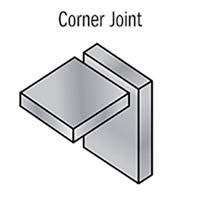
Corner weld-joint
There are several variations of corner weld joints, including fillet, bevel, and V-groove configurations. Fillet welds are the most common type of corner joint, involving a triangular-shaped weld along the interior angle of the connection. Bevel and V-groove welds, on the other hand, involve welding along the exterior angle of the connection. The choice between these configurations will depend on factors such as the thickness and type of material being welded, as well as the desired strength and appearance of the joint.
In addition to their primary uses in construction and fabrication, corner weld joints can also be found in various other industries and applications. For example, they are used in the assembly of electronic devices, automotive components, and even artwork.
3. Lap Weld Joints
Lap weld joints involve overlapping two pieces of metal and welding along the edges of the overlap. This type of joint is highly versatile and can be used in a wide range of applications and scenarios. One of the main advantages of lap weld joints is their ability to provide a strong, durable connection without the need for extensive edge preparation or beveling. This can help to save time and resources in the welding process, making lap joints a popular choice in many industries.

Lap weld joints can be created using various welding processes, including gas metal arc welding (GMAW), shielded metal arc welding (SMAW), and gas tungsten arc welding (GTAW), among others. The choice of welding process will depend on factors such as the type and thickness of the material being welded, as well as the specific requirements of the application.
Common scenarios in which lap weld joints are used include the construction of tanks, vessels, and other structures that require a watertight or airtight seal. Additionally, lap joints are often employed in the fabrication of sheet metal products, such as ductwork and automotive components.
4. Edge Weld Joints
Edge weld joints involve welding the edges of two pieces of metal that are placed next to each other. This type of joint is less common than the others discussed thus far, but it can be useful in certain situations. One of the main advantages of edge weld joints is their ability to provide a flat, continuous connection between the metal pieces, making them ideal for applications where a smooth, even surface is required.
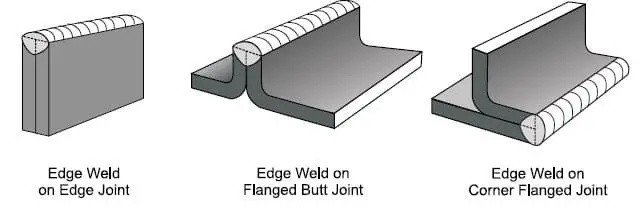
Edge weld joints
To create an edge weld joint, the edges of the metal pieces must be prepared by cleaning and grinding them to ensure a strong, clean bond. Once the edges are prepared, the welding process can begin. Edge weld joints can be created using various welding processes, including GMAW, SMAW, and GTAW, among others.
Some common applications of edge weld joints include the fabrication of sheet metal products, such as panels, covers, and doors, as well as the assembly of electronic devices and components. In these cases, the edge weld joint provides a strong, secure connection without compromising the appearance or functionality of the finished product.
5. T-Joint Welds
T-joint welds (also known as tee joint welds) involve connecting the end of one piece of metal to the middle of another, forming a T-shape. This type of joint is commonly used in structural applications, such as beams, supports, and other load-bearing elements. For example, T-joints in aluminum welding provide a strong, stable connection between the two metal pieces, which is essential for maintaining the integrity and functionality of the structure.
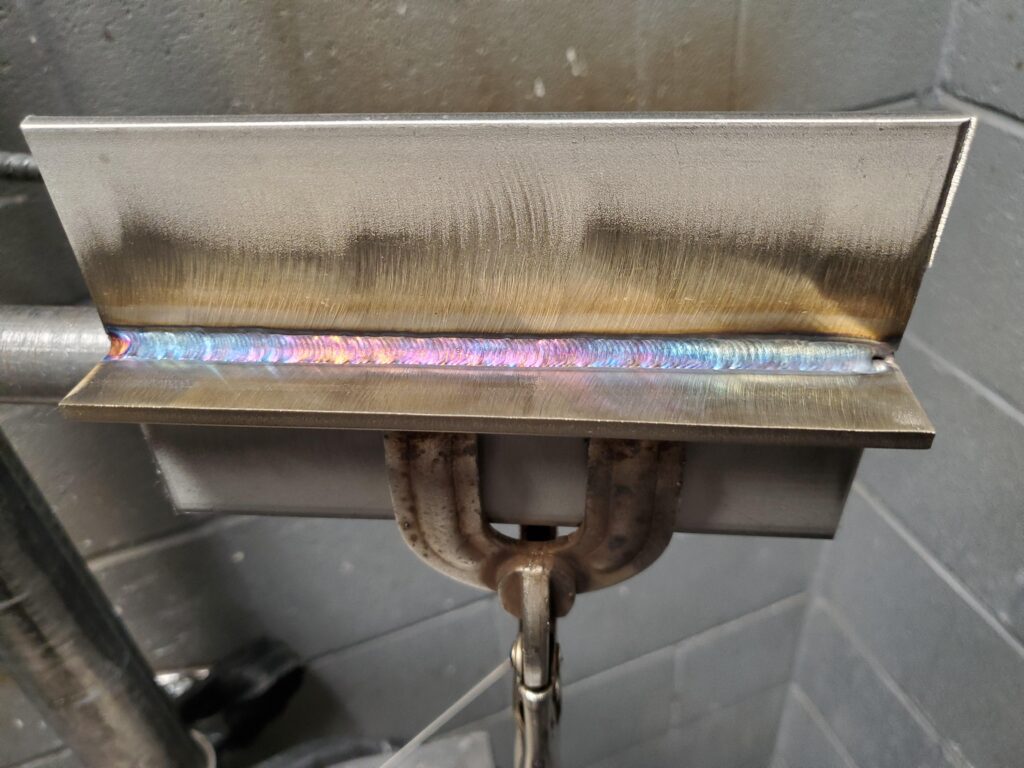
T-weld
T-joint welds are used in a wide range of industries and applications, including construction, manufacturing, automotive, and aerospace, among others. In each of these industries, the T-joint weld provides a critical connection that helps to ensure the overall performance and durability of the finished product or structure.
Choosing the Right Types of Welding Joints for Your Project
Selecting the appropriate weld joint type for a sheet metal project is essential for achieving the best results in terms of strength, durability, and efficiency. To make the right choice, it is important to consider factors such as the type and thickness of the materials being welded, the specific requirements of the application, and the available welding processes and equipment.
In some cases, it may be necessary to consult with a welding professional or engineer to determine the best joint type for a particular project. These experts can provide valuable guidance based on their knowledge and experience, helping to ensure that the chosen types of welding joints will meet the needs and expectations of the application.
Below is a comparison table that shows different criteria for specified weld joint types:
Table: Comparison of weld joints
| Weld Joint Type | Strength | Appearance | Welding Difficulty | Application |
|---|---|---|---|---|
| Butt Weld Joints | Strong and durable | Neat and clean | Moderate to difficult | Structural applications, pipelines, metal furniture |
| Corner Weld Joints | Strong and durable | Visible weld bead | Moderate to difficult | Box structures, frames, corners |
| Lap Weld Joints | Moderate strength | Partially visible weld bead | Relatively easy | Sheet metal fabrication, overlapping joints |
| Edge Weld Joints | Moderate strength | Partially visible weld bead | Relatively easy | Joining edges of two metal pieces |
| T-Joint Welds | Moderate to strong | Visible weld bead at the intersection | Moderate to difficult | Connecting one metal piece to another at a right angle |
(Please note that the above table provides a general overview and the suitability of each weld joint type may vary depending on specific applications and welding techniques used.)
Tips for Achieving Optimal Performance and Efficiency with Weld Joints
Regardless of the specific type of weld joint being used, there are several key factors to consider to achieve optimal performance and efficiency:
1. Proper Edge Preparation
Beveling, chamfering, cleaning, or grinding the edges of the metal pieces to the appropriate specifications to ensure a strong, clean bond.
2. Adequate Penetration
Ensuring that the filler material penetrates fully into the joint is critical for creating a strong, durable connection. The specific penetration requirements will depend on the type of joint and the materials being welded.
3. Proper Welding Technique
Employing the correct welding technique is essential for achieving a high-quality weld joint. This includes following the recommended procedures and settings for the chosen welding process, as well as using the proper welding equipment and accessories.Next, the common welding techniques include laser welding, TIG welding techniques, MIG, stick welding etc.
4. Regular Inspection and Maintenance
Regularly inspecting and maintaining welded connections can help to ensure their continued performance and durability. This may involve visual inspections, non-destructive testing, or other evaluation methods, depending on the specific application and requirements.
Prolean’s Welding Services: Precision and Perfection
For those in need of expert welding services or sheet metal survices, Prolean offers a comprehensive range of solutions designed to meet the needs of various industries and applications. Our team of skilled welders and engineers have extensive experience in working with a wide variety of materials and weld joint types, ensuring that each project is completed with precision and perfection. Whether it’s a small, intricate component or a large, complex structure, Prolean has the expertise and resources to deliver exceptional results on time and within budget.
Try Prolean Now!
Summing Up
Understanding the various types of welding joints and their applications is crucial to achieving optimal results in terms of performance, efficiency, and durability. By selecting the appropriate joint type for a particular project and following best practices for edge preparation, penetration, and welding technique, you can create strong, long-lasting connections that meet the needs of different industries and applications. With the assistance of experienced professionals like the team at Prolean, you can ensure that your welding projects are completed to the highest standards of quality and craftsmanship.
FAQ’s
What are the five primary types of welding joints?
The five primary types of welding joints are butt, corner, lap, edge, and T-joint.
How do I choose the right welding joint for my project?
To choose the right welding joint, consider factors such as the type and thickness of the materials being welded, the specific requirements of the application, and the available welding processes and equipment.
What is the importance of edge preparation in welding joints?
Edge preparation is essential for ensuring a strong, clean bond between the metal pieces being welded. Proper edge preparation may involve beveling, chamfering, cleaning, or grinding the edges of the metal pieces to the appropriate specifications.
What are some tips for achieving optimal performance and efficiency with weld joints?
Some tips for achieving optimal performance and efficiency with weld joints include proper edge preparation, adequate penetration, proper welding technique, and regular inspection and maintenance.
How can I ensure the quality of my welding joints?
To ensure the quality of your welding joints, work with experienced professionals like the team at Prolean, who have the expertise and resources to deliver exceptional results on time and within budget.




I found the content interesting, thanks. Can you tell me that What can be the best type of welding joint for stainless steel ladder?
Thank you for your query, i think T-joint or fillet weld, can be a best option as it it provides strong, durable connections ideal for supporting weight and resisting stress.